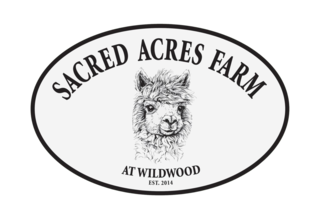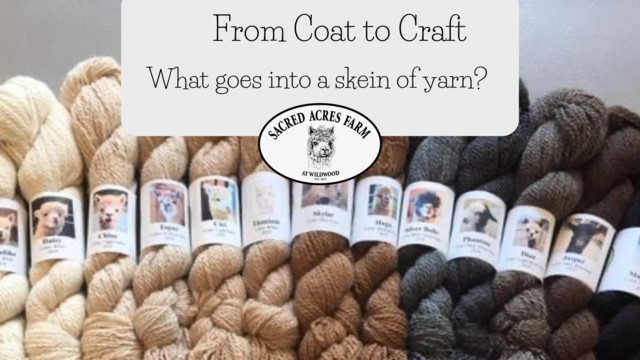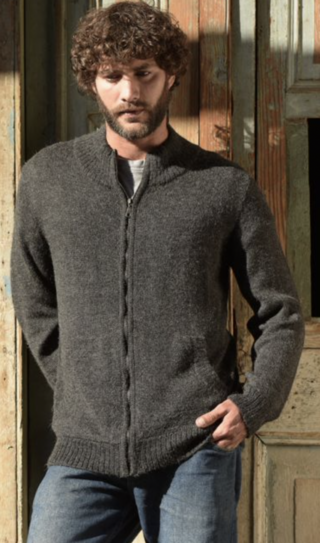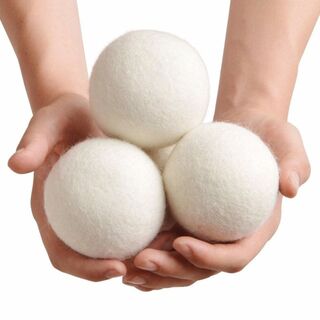From Coat to Craft | What Goes Into Making A Skein of Alpaca Fiber Yarn? (Part 2)
Wednesday, November 23, 2022
Hey Farm Friends,
Happy Thanksgiving! I hope you all are deep into your food comas and enjoying quality time with the family. While you are relaxing and contemplating that fourth plate while planning out your route for Black Friday sales, why not add our farm into your schedule? We will be running specials online and in store for Black Friday, Small Business Saturday, and digital sales on our online store only on Cyber Monday. Whether you are getting prepared to bundle up with the plummeting temperatures or looking to kickstart your holiday shopping, we have everything you need. Enjoy alpaca themed toys and trinkets for the kids, cozy up with 20% off blankets and throws, surprise that one family member that seems to have everything with the one-of-a-kind gift of alpaca sponsorship, or stock up your craft-lover with 10% off your entire yarn purchase when you buy more than 5 skeins of yarn.
Avoiding the same old dinner table conversations of many a Thanksgiving, I thought it would be fun to offer up some more insight about alpaca farming and the process of the creation of a skein of yarn. In our last post we discussed some of the daily and weekly costs and responsibilities of alpaca farming and the investments involved in that. You can see that on our blog under “From Coat to Craft | What Goes Into Making A Skein of Yarn (Part 1).” This time we are going to go into depth on some of the monthly and yearly tasks.
Monthly - What is Herd Health?
One of the biggest to-dos for alpaca on a month-to-month basis has got to be Herd Health. Herd Health is just what it sounds like, the monthly medical and grooming upkeep with the alpaca. This is when they receive their vaccinations, get their toenails trimmed, and a great time to focus on different training tasks like walking on a lead.
Everyone gets slightly different shots based around their weight. The regularity/frequency of Herd Health also changes when taking into consideration any pregnant alpacas. And while it is good to check on their toenails, not every alpaca will need their nails trimmed every month since each alpaca has a different rate of growth of their toenails.
**Interesting Fact** Did you know that typically the toenails of white alpacas grow a lot faster than that of other colored alpacas?
The primary purposes of trimming an alpaca’s toenails are to give them an even, flat footing and to clean out any accumulated debris or dirt from their footpads in order to prevent infections. Like cats and dogs, alpacas have a soft tissue in the center of their nails known as the quick that is important to be mindful of when you are trimming. Cutting the quick by accident can be very painful and may result in bleeding.
Halter training or walking on a lead is definitely important to work on with alpacas, regardless of whether they are going to be visited by farm guests. This is vital knowledge for transportation in emergencies, for vet visits, or evacuations. The first time you are walking an alpaca on a lead should not be in a state of emergency. It is important to practice. Properly fitting halters are important to have. Alpacas have a bone that comes not very far down their faces towards their nose. It is important to ensure that the halter is sitting on the bone so that it does not push down on the cartilage and suffocate the alpacas. A good physical indicator that their halter may be misaligned is their nostrils flaring while the halter is on. This shows that it is too far down, too tight, and needs to be adjusted.
For the monthly financial perspective, it is looking at medications for each alpaca as well as the needles to inject them, halters and leads, and toenail trimmers.
YEARLY - Shearing Time!
The expenses to prepare for yearly are going to be shearing, fiber processing, and the vet. For the most part, veterinarians for the alpacas only need to come out once a year, twice depending on if they require extra vaccinations of CDT (the core vaccination for camelids that protect against clostridial diseases).
Once a year, everyone gets shorn. Typically this is in late spring to prepare for the summer heat. This is vital for the comfort and well-being of the alpacas. One fun thing that you will notice is the immediate dirt baths. Like dogs, you will see alpacas occasionally roll around on their backs in the dirt for fun. This is entertaining and relieving for the alpacas, and super funny to watch. I am currently working on getting all of the previous live streams onto YouTube and I will see if I can find an example to post a short/reel of because it is absolutely adorable.
The fiber is then bagged and sent off to a fiber processing mill. Now, there are ways to learn to do fiber processing in house and that is something that you can see the tools for in our farm store during your visit. Basically, once the fiber is shorn and bagged, it is then deeply and thoroughly washed and dried. From there, the fiber goes through a picker to get out additional debris and is brushed in one direction and prepped to be spun. You will notice a wheel with a pedal on the side of the store, that is what is used to spin the fiber into thread. And with enough fiber, you will have your skein of yarn!
Wild, right? It is always so interesting to learn the depth and detail that goes into something seemingly so simple as a skein of yarn. But truly there is so much work that goes into the creation of the materials that you see. Another fascinating quality of the fiber as well is that, even if two alpacas are the same color, the shading of the yarn may be inconsistent between the two. This is due to the nature of the fiber differing from alpaca to alpaca. If you are interested in crafting with alpaca fiber, come on by and check out our selection of 14 natural shades right from our own alpacas. Currently, we are still running our yarn sale. When you buy more than 5 skeins of yarn, you will receive 10% off your entire yarn purchase.
Maybe your New Year's resolution is like mine and you want to spend 2023 picking up a new craft. Why not join me over on YouTube at Sacred Acres Farm at Wildwood's page and we will learn step-by-step how to make simple yarn crafts. I want to build up to making myself a cardigan by next winter. Join me for the journey and subscribe to the channel. There you will also find reposts of our live streams, alpaca facts, and videos of the farm. Hope to see you there! Talk to you next week, farm friends.
Happy Thanksgiving! I hope you all are deep into your food comas and enjoying quality time with the family. While you are relaxing and contemplating that fourth plate while planning out your route for Black Friday sales, why not add our farm into your schedule? We will be running specials online and in store for Black Friday, Small Business Saturday, and digital sales on our online store only on Cyber Monday. Whether you are getting prepared to bundle up with the plummeting temperatures or looking to kickstart your holiday shopping, we have everything you need. Enjoy alpaca themed toys and trinkets for the kids, cozy up with 20% off blankets and throws, surprise that one family member that seems to have everything with the one-of-a-kind gift of alpaca sponsorship, or stock up your craft-lover with 10% off your entire yarn purchase when you buy more than 5 skeins of yarn.
Avoiding the same old dinner table conversations of many a Thanksgiving, I thought it would be fun to offer up some more insight about alpaca farming and the process of the creation of a skein of yarn. In our last post we discussed some of the daily and weekly costs and responsibilities of alpaca farming and the investments involved in that. You can see that on our blog under “From Coat to Craft | What Goes Into Making A Skein of Yarn (Part 1).” This time we are going to go into depth on some of the monthly and yearly tasks.
Monthly - What is Herd Health?
One of the biggest to-dos for alpaca on a month-to-month basis has got to be Herd Health. Herd Health is just what it sounds like, the monthly medical and grooming upkeep with the alpaca. This is when they receive their vaccinations, get their toenails trimmed, and a great time to focus on different training tasks like walking on a lead.
Everyone gets slightly different shots based around their weight. The regularity/frequency of Herd Health also changes when taking into consideration any pregnant alpacas. And while it is good to check on their toenails, not every alpaca will need their nails trimmed every month since each alpaca has a different rate of growth of their toenails.
**Interesting Fact** Did you know that typically the toenails of white alpacas grow a lot faster than that of other colored alpacas?
The primary purposes of trimming an alpaca’s toenails are to give them an even, flat footing and to clean out any accumulated debris or dirt from their footpads in order to prevent infections. Like cats and dogs, alpacas have a soft tissue in the center of their nails known as the quick that is important to be mindful of when you are trimming. Cutting the quick by accident can be very painful and may result in bleeding.
Halter training or walking on a lead is definitely important to work on with alpacas, regardless of whether they are going to be visited by farm guests. This is vital knowledge for transportation in emergencies, for vet visits, or evacuations. The first time you are walking an alpaca on a lead should not be in a state of emergency. It is important to practice. Properly fitting halters are important to have. Alpacas have a bone that comes not very far down their faces towards their nose. It is important to ensure that the halter is sitting on the bone so that it does not push down on the cartilage and suffocate the alpacas. A good physical indicator that their halter may be misaligned is their nostrils flaring while the halter is on. This shows that it is too far down, too tight, and needs to be adjusted.
For the monthly financial perspective, it is looking at medications for each alpaca as well as the needles to inject them, halters and leads, and toenail trimmers.
YEARLY - Shearing Time!
The expenses to prepare for yearly are going to be shearing, fiber processing, and the vet. For the most part, veterinarians for the alpacas only need to come out once a year, twice depending on if they require extra vaccinations of CDT (the core vaccination for camelids that protect against clostridial diseases).
Once a year, everyone gets shorn. Typically this is in late spring to prepare for the summer heat. This is vital for the comfort and well-being of the alpacas. One fun thing that you will notice is the immediate dirt baths. Like dogs, you will see alpacas occasionally roll around on their backs in the dirt for fun. This is entertaining and relieving for the alpacas, and super funny to watch. I am currently working on getting all of the previous live streams onto YouTube and I will see if I can find an example to post a short/reel of because it is absolutely adorable.
The fiber is then bagged and sent off to a fiber processing mill. Now, there are ways to learn to do fiber processing in house and that is something that you can see the tools for in our farm store during your visit. Basically, once the fiber is shorn and bagged, it is then deeply and thoroughly washed and dried. From there, the fiber goes through a picker to get out additional debris and is brushed in one direction and prepped to be spun. You will notice a wheel with a pedal on the side of the store, that is what is used to spin the fiber into thread. And with enough fiber, you will have your skein of yarn!
Wild, right? It is always so interesting to learn the depth and detail that goes into something seemingly so simple as a skein of yarn. But truly there is so much work that goes into the creation of the materials that you see. Another fascinating quality of the fiber as well is that, even if two alpacas are the same color, the shading of the yarn may be inconsistent between the two. This is due to the nature of the fiber differing from alpaca to alpaca. If you are interested in crafting with alpaca fiber, come on by and check out our selection of 14 natural shades right from our own alpacas. Currently, we are still running our yarn sale. When you buy more than 5 skeins of yarn, you will receive 10% off your entire yarn purchase.
Maybe your New Year's resolution is like mine and you want to spend 2023 picking up a new craft. Why not join me over on YouTube at Sacred Acres Farm at Wildwood's page and we will learn step-by-step how to make simple yarn crafts. I want to build up to making myself a cardigan by next winter. Join me for the journey and subscribe to the channel. There you will also find reposts of our live streams, alpaca facts, and videos of the farm. Hope to see you there! Talk to you next week, farm friends.





